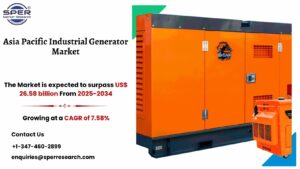United States Warehouse Robotics Market Size, Trends, Industry Share, Revenue, Demand, Growth Drivers, Challenges, Key Manufactures, CAGR Status and Future Competition Till 2033: SPER Market Research

Market Overview and Growth Insights: Automated systems like robots, drones, and self-driving cars are used in warehouse robotics to optimise operations in distribution and storage facilities. These systems are made to efficiently and precisely complete operations including picking, packaging, sorting, inventory management, and transportation. The need for increased precision, lower prices, and faster operations has made the technology a crucial component of the larger industrial automation scene. The capabilities of warehouse robotics have been greatly expanded by developments in artificial intelligence (AI), machine learning, and the Internet of Things (IoT), allowing for seamless integration into intricate supply chain settings. Warehouse robots is revolutionising the management, storage, and delivery of products as companies place a higher priority on scalability and agility.
As per SPER Market Research, the report titled “United States Warehouse Robotics Market Size – By Type, By Function, By End User – Regional Outlook, Competitive Strategies, and Segment Forecast to 2033″ projects that the U.S. warehouse robotics market will grow at a compound annual growth rate (CAGR) of 11.83%, reaching a valuation of USD 19.52 billion by 2033.
Drivers: The market for warehouse robotics in the United States is driven mainly by the rapid expansion of e-commerce, which necessitates accurate inventory management and quicker order fulfilment. The necessity for automation has been further highlighted by labour shortages and high turnover rates in warehouse operations. Cost effectiveness is crucial since robotics lowers labour costs, speeds up operations, and minimises errors, all of which lower long-term operating costs. Robotic systems are now far more flexible, accurate, and reliable thanks to technological developments like artificial intelligence (AI), machine learning, machine vision, and the Internet of Things. Automation has become a strategic need as a result of businesses implementing robotics to reduce the dangers associated with manual handling and repetitive operations due to increased emphasis on workplace safety and regulatory compliance.
Download sample PDF copy of this report to understand structure of the complete report @ https://www.sperresearch.com/report-store/united-states-warehouse-robotics-market.aspx?sample=1
Restraints: The warehouse robotics market in the United States is confronted with formidable obstacles, notwithstanding its advantages. Many small and medium-sized businesses (SMEs) are put off by the high upfront expenses associated with buying and deploying robotic systems. The intricacy of incorporating robotics into the software and infrastructure of an existing warehouse can also cause delays and need for specific knowledge. Another issue is cybersecurity, since linked robotic systems are more susceptible to data leaks and hacking. Additionally, some robotic solutions’ low customisability limits their use in sectors that demand specialised procedures. All of these issues make it difficult for warehouse robotics to be widely adopted, especially by companies with tight budgets or extremely precise operating requirements.
Impact of COVID-19: Warehouse robots was adopted in the United States as a result of the COVID-19 epidemic, which caused manual operations to be disrupted by health issues and labour shortages. The pandemic’s spike in demand for online shopping and supply chains made automation even more critical to managing higher order volumes accurately and efficiently. Although the delivery and deployment of robotic systems were initially delayed by supply chain interruptions, businesses promptly gave automation top priority in order to maintain business continuity. Robots are a vital tool for resilience since they made contactless operations possible, decreased reliance on human labour, and improved safety procedures. The strategic significance of warehouse robotics in responding to unanticipated disruptions and satisfying changing market demands was brought to light at this time.
Key Players: United States Warehouse Robotics Market is dominated by California region due to its advanced technological infrastructure and high adoption rates of automation across industries. Some of its key players are – Zebra Technologies Corp, GreyOrange Pte Ltd, Locus Robotics Corporation, inVia Robotics, FANUC America Corporation.
United States Warehouse Robotics Market Segmentation:
By Type: Based on the Type, United States Warehouse Robotics Market is segmented as; Articulated, Gantry, Automated Storage and Retrieval System (ASRS), Mobile, Others.
By Function: Based on the Function, United States Warehouse Robotics Market is segmented as; Storage, Trans-shipments, Packaging, Others.
By End User: Based on the End User, United States Warehouse Robotics Market is segmented as; Food and Beverages, Automotive, Retail, Electronics and Electrical, Pharmaceuticals, Others.
By Region: This research also includes data for North, South, West and Mideast.
For More Information in United States Warehouse Robotics Market, refer to below link –
US Warehouse Robotics Market Share
Others Industry Report –
- UAE Experiential Learning Market Size- By Age Group, By Subscription Type, By Grade- Regional Outlook, Competitive Strategies and Segment Forecast to 2032
- USA Used Car Market Size- By Vendor Type, By Fuel Type, By Body Type, By Sales Channel- Regional Outlook, Competitive Strategies and Segment Forecast to 2032
Follow Us –
LinkedIn | Instagram | Facebook | Twitter
Contact Us:
Sara Lopes, Business Consultant – U.S.A.
SPER Market Research
+1-347-460-2899





